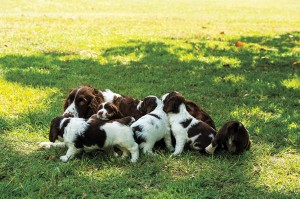 This past winter was mild and a local trap club is quite close, making it easy to get a few rounds in; the real point being to keep shooting year-round. It stinks to miss average shots after your gun dog has busted a gut putting a rooster in the air. After shooting, several of us occasionally reminisce about upland hunting. A recent session had me thinking about past seasons and past dogs.
This past winter was mild and a local trap club is quite close, making it easy to get a few rounds in; the real point being to keep shooting year-round. It stinks to miss average shots after your gun dog has busted a gut putting a rooster in the air. After shooting, several of us occasionally reminisce about upland hunting. A recent session had me thinking about past seasons and past dogs.
First we discussed how to get a new pup. It is not rocket science, but it can take some legwork. And it's worth it. My field-bred English springer spaniels have typically given me 11-14 years of hunting.
One cannot usually expect a strong showing until pup's third year, continuing up to his 10th or 11th. So it is imperative to buy a pup with the goods to make a sound, strong-performing gun dog.
There are no guarantees when buying puppies, but one's best bet is to buy from field-bred litters, and to buy from the best of these. Ideally, both dam and sire have been trialed, and while winning is not a necessary ingredient, competitive dogs should be the basis of your puppy's selection. This method can be argued, but results are what count, and this method provides results.
I had the good fortune to get several of my early springers from Ru-Char breeding, both directly and indirectly. I purchased one dog directly from Ruth Greening, the renowned Ru-Char breeder, and others from close friends of hers like the late Ed Burger and Gary Wilson, the successful eastern pro.
Greening was very influential in the springer game. Burger said of her, "Ruth not only bred, trained and trialed the best dogs; she taught many of the top trainers/trialers, including pros, in the East."
Buying pups from the best litters available works if you do your part. Some breeders of the very top competitive dogs may not sell to those not intending to enter field trials. Face it; these successful breeders and field trialers have a lot of money and incalculable time invested in their dogs and feel they need to sell them to folks who will showcase them successfully in field trials.
Owners of many successful field-trial dogs will sell to hunters, however, especially serious hunters — i.e., not someone who goes out only once or twice a season.
No Shortcuts
Here's a reality check for buyers of top pups they want to become good gun dogs. If you do not have at least four days a week during the first year to spend 20 minutes (and later 30-40 minutes) with pup working on the basics or yard training, you can probably skip the earlier legwork and just buy whatever pup you can find. There are no miracles to having good gun dogs. One needs a good pup and then must pay his dues via time and effort.
Go see an AKC field trial or two and an AKC hunt test of two. Doing this will likely involve a bit of time, travel and inconvenience, but it is worth it if you want a good dog. The average hunter will be intimidated by the quality of dogs he sees competing in field trials. Without seeing a licensed AKC spaniel field trial, you will never know what a spaniel can accomplish. (Reminder: Take an orange hat and orange vest to wear to both trials and tests.)
Hunters following the advice above will likely have the best gun dog of anyone they know other than field trialers or pretty serious hunt
test participants. Talk to a couple of club officers/members of the host club and request an invitation to a training session. Join or at least get involved with the club, and perhaps train with them. If you are genuinely interested in a good gun dog, doing this can help accomplish that goal.
Ru-Char Lineage
Back to those reminisces: Sam, my first field-bred springer, came one generation removed from the Ru-Char kennels, and he gave me a glimpse of our future when 6 months old. I tossed Sam a wing-clipped pigeon and the bird got a bit too much wind under his wings. He flew 100 yards and landed in a fallen tree held off the ground by its branches.
The bird was 12 feet off the ground and Sam jumped upon the tree's lower branches, climbing along the trunk using random branches while his legs splayed every which way. He nearly reached the bird before it flushed and reached another tree. I knew I had an outstanding hunting dog, and he proved it regularly until he was 11 years old. For another year he'd get a half-hour hunt or just a planted bird. At 13 he succumbed to cancer.
Boots came directly from the Grande Dame of spaniels, Ruth Greening. He had more liver coloring than I like, but he was all business. Boots was a good all-around gun dog, but especially good in water. Pheasants are my favorite gamebird but when I was young I liked to take an occasional crack at ducks along creeks.
I used two techniques: sneaking along the banks of mid-sized creeks or anchoring a few decoys at a small bend in the creek. Boots did very well when I knocked birds down.
Boots loved the water and learned to allow for the current to carry a duck downstream. Only one time did I worry about Boots getting caught up in a downed tree, and it was unnecessary.
A big mallard was a bit large for Boots, but he managed. Woodies were just his size.
CJ is my current springer, and after Sam, my favorite. Sam admittedly had the advantage of being my first field-bred springer. CJ was bred by Ben Martin using a strong sire, the son of a National Field Champion, Field Champion and Amateur Field Champion, KB's Sir Coach.
CJ was shortchanged on time because of my new job at the time he arrived, but still he turned out to be a fine gun dog and a great family dog. For some time I have hunted alone and CJ learned to work hedgerows especially well. Not only did he run birds down and flush them, he was able to make retrieves on whichever side of the hedgerow the bird fell. That's not as easy as it sounds with only one hunter and one dog.
Every field-bred gun dog I ever had came from superior breeding. Those dogs' parents provided an excellent base: good nose, good drive, good attitude, good retrieving instinct and a strong desire to please. It does not get any better than that, and good breeding is where it starts.
Bernie the Brittany
Bernie, a bold, beautiful, birdy Brittany, is 3 months old and owned by Noah and Mindy Clark of Gresham, Ore.
Pup on the Prowl
This proud puppy looks like a noble lion on the prowl — one of the reasons we love the spunky character of young pups everywhere.
Dog Days of Summer
All went "swimmingly" with this photo shoot! This litter of Boykin spaniel puppies is owned by Bill and Dawn Crites of Blythwood, S.C.
Pick of the Litter
The spotlight is on the pick of the litter, LuLu! The cocker spaniel is owned by Nevena Martin.
Accessorize
Every girl needs a good bag, including Ellie, a Chesapeake Bay retriever belonging to George Vandel of Pierre, S.D.
Start 'Em Young
Sixteen-week-old Roba, a Weimaraner, is now an exceptional bird dog, according to Dennis Volpe of Wilmington, Mass.
Casting a Shadow
Casting a perfect shadow is Dakota, a 14-month-old English setter puppy owned by D.J. Clark.
French Import
Hiver de la Pierre d'Or (Evie) is a Braque du Burbonnais. Pictured here at 6 months, Evie is a French import that now lives happily in Michigan with owner Erin Feichtner.
Makin' Waves
Makin' waves! This lab pup belongs to Robert Knupp.
Autumn Greetings
Autumn greetings! These lab puppies are owned by T.J. and Mercedes Jones of Laurel Hill, Fla., and were photographed by family friend Shanna.
Zeus
Zeus, a German shorthaired pointer, is owned by Mario Notarfrancesco of Melbourne, Australia. He is pictured retrieving a grey teal and has a bright future ahead of him hunting ducks and quail "down under."
Proud Pup
This proud pup strikes a pose for the camera — yet another reason we love collecting pics from the cutest puppies around.
Doggy Daydreams
Twelve-week-old Sage, a Labrador owned by Gina Pfister, is undoubtedly daydreaming of hunts to come.
Puppy Bins
Bins full of puppies! This litter of English setters, on their first trip to the vet at 6 weeks, are owned by Dave Jungst of Morris, Minn.
All About the Attitude
Attitude — with a capital "A." English setter Kota has the heart of a lion when it comes to hunting, according to owner Diane Peterson of Wisconsin.
Working Man's Dog
This little firecracker was born on the 3rd of July. When not mowing the lawn, Major Winters, a vizsla, loves being in the woods and learning about hunting, according to owner Bill McGough.
A Good Chew
"Ropes and strings and chewy things!" Georgia de L'Etoile du Nord, a French Brittany, is owned by Kelly and Renae Kappes of Ada, Minn., and was photographed by their son, Ryan.
Baby Blues
Talk about a pair of blue-eyed cuties! Kym Lish's daugher Piper holds a German shorthair pup from their recent litter.
High Five
High fives all around — let's hunt! Baked in the Sun "Boise" Paw'Tater is owned by Caroline Fenton.
Just Chillin'
Popper is a deaf English setter puppy fostered for Ohio English Setter Rescue by Danica Barreau. He quickly learned hand signs, was adopted and now lives a spoiled life with an adoring family.
Nose to Nose
"Let's discuss this nose-to-nose!" Copper, a 7-year-old male English pointer, becomes acquainted with Todd, a 13-week-old female German shorthair owned by Ashley Stevens.
Dog Daze
This is GCH Truly A Daydream Believer JH when she was four-and-a-half months old. The Irish Red & White Setter belongs to Ed and Wendy Brockman of New Tripoli, Penn.
Romp in the Field
This pup took a romp in a field — one of the reasons we love getting reader photos of young, scrappy little pups.
First Bird
Seven-week-old Bryar, a German shortaired pointer, shows off his first dove retrieve. According to his owner, Jennifer Horan of Manchester, Penn., Bryar has become a bird hunting machine.
Win a 2013 Gun Dog Puppies Calendar!






